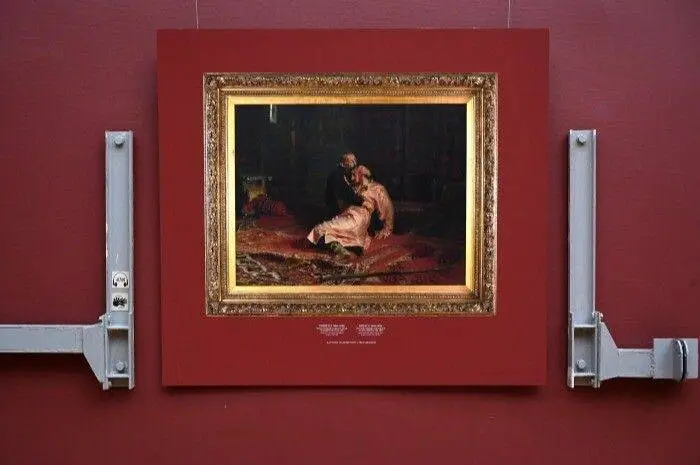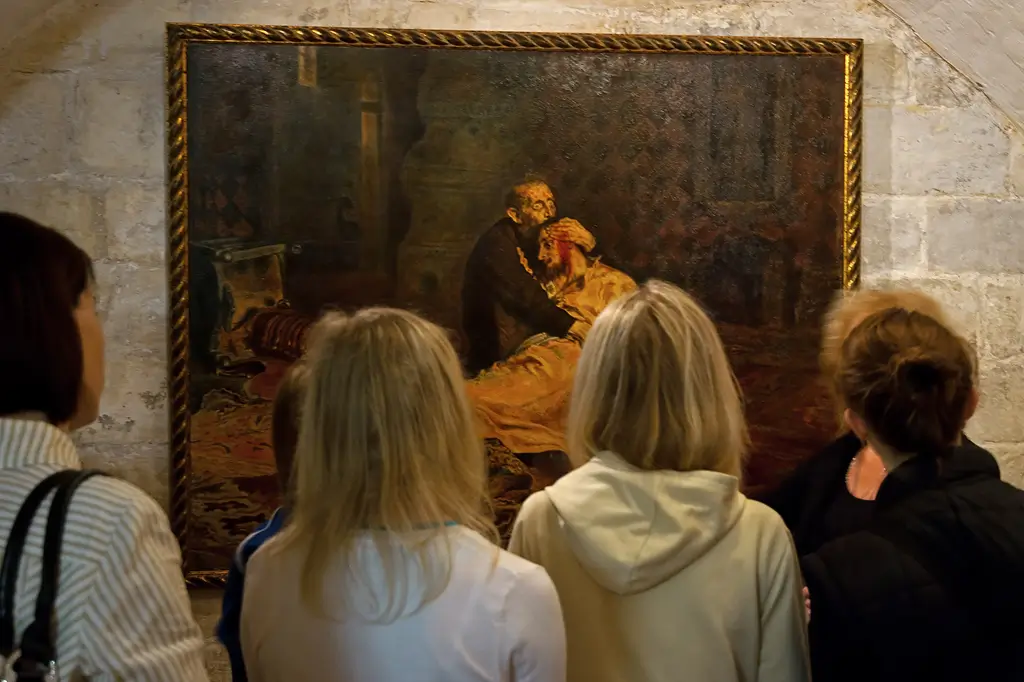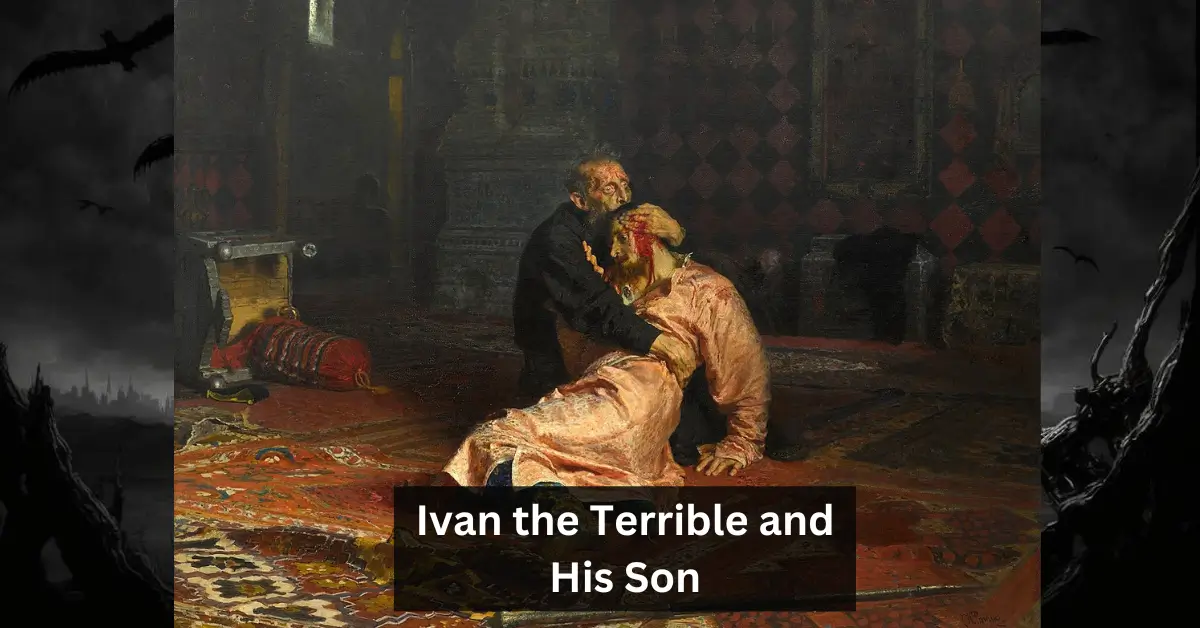In the world of art and history, few works evoke the same powerful emotions as Ilya Repin’s painting Ivan the Terrible and His Son. This haunting masterpiece not only captures a moment of tragic intensity but also provides insight into the lives of two pivotal figures in Russian history: Ivan IV, better known as Ivan the Terrible, and his son, Ivan Ivanovich.
As a reflection of Russian history, autocracy, and human suffering, this painting stands as one of the most famous and revered works in Russian art. But what lies behind the strokes of Repin’s brush, and why does this painting continue to captivate audiences today?
To understand this extraordinary work, we must explore the context in which it was created, the historical event it portrays, and the brilliance of the artist behind it. This article delves into the tragic tale of father and son, as well as the symbolic power of this painting, its reception, and its lasting legacy in Russian culture.
Overview of Ivan the Terrible and His Son Painting
Ilya Repin’s Ivan the Terrible and His Son was completed in 1885 and is considered one of the most psychologically complex and emotionally charged pieces of Russian art. The painting vividly portrays the moment when Ivan the Terrible, in a fit of rage, strikes his son, Ivan Ivanovich, with a fatal blow.
In the aftermath of this violent act, Ivan cradles his dying son, his face contorted with horror and regret. The scene is steeped in emotion, capturing the sheer devastation of the Tsar as he realizes the gravity of his actions.

The painting has been widely praised for its exceptional use of color, light, and shadow to convey emotional depth. Repin’s skillful depiction of the anguish on Ivan’s face, contrasted with the stillness of his son, creates a powerful visual impact. The painting is housed in Moscow’s renowned Tretyakov Gallery and remains one of the most celebrated pieces of Russian art.
The Historical Background: Ivan the Terrible and His Son
The real-life event that inspired this painting occurred in 1581 during the reign of Ivan IV, the first Tsar of Russia. Ivan, known for his unpredictable and often violent nature, struck his son Ivan Ivanovich in a moment of uncontrollable fury.
Historians believe the incident may have been triggered by a disagreement over military or political matters, or even personal disputes. Ivan Ivanovich succumbed to his injuries, leaving Russia without a direct heir and plunging the country into a period of instability.
This event, shrouded in mystery and speculation, has become one of the most infamous moments in Russian history. Some accounts suggest that the blow was accidental, while others argue it was the result of Ivan the Terrible’s increasingly erratic behavior. Regardless, the incident marked a turning point in Ivan’s reign and his legacy as one of the most feared rulers in Russian history.
Ilya Repin: The Artist Behind the Masterpiece
Ilya Repin was one of the most celebrated Russian artists of the 19th century, known for his ability to capture raw human emotion and complex psychological states. Born in 1844, Repin rose to prominence for his works that depicted scenes from Russian history and everyday life with remarkable realism.
His deep understanding of the human psyche, coupled with his technical skill, made him the ideal artist to take on the dramatic story of Ivan the Terrible and his son.
Repin’s decision to paint this particular scene was no accident. He was drawn to the psychological complexity of Ivan IV, a ruler whose reign was marked by both significant achievements and brutal tyranny. Through this painting, Repin sought to explore the inner turmoil of Ivan the Terrible, showing him not as a one-dimensional tyrant but as a father grappling with the consequences of his own rage.
Also Read: Mother Gothel
The Scene Depicted in the Painting
At the heart of Ivan the Terrible and His Son is the moment of profound realization and regret. Ivan the Terrible holds his son in his arms, blood seeping from the wound inflicted by his own hand. His expression is one of horror, as though he cannot believe what he has done. His son, Ivan Ivanovich, is depicted with an expression of pain but also forgiveness, his eyes soft despite the violence that has just occurred.
Repin’s attention to detail is extraordinary, from the way the blood contrasts with the rich textures of their clothing to the intense emotions on their faces. The scene is intimate, drawing the viewer into the moment as if they are witnessing the tragedy firsthand. It is this emotional intensity that has made the painting so enduringly powerful.
Symbolism and Themes in Ivan the Terrible and His Son
Beyond the literal depiction of the historical event, Ivan the Terrible and His Son is rich with symbolism and deeper themes. The painting explores the destructive nature of unchecked power and the consequences of autocracy. Ivan IV’s violent temper, driven by his absolute authority as Tsar, ultimately leads to the death of his heir—an act that symbolizes the self-destruction of tyranny.
The painting also delves into the father-son relationship, a theme that has universal resonance. The tragedy is not just political but personal, as it depicts a father’s profound regret over his actions against his own flesh and blood. This duality—public authority and private guilt—makes the painting both historically significant and emotionally timeless.
The Controversial Reception of the Painting
When Repin first unveiled Ivan the Terrible and His Son, it sparked controversy. Some saw it as a critique of Russian autocracy, particularly at a time when the country was still ruled by the Tsarist regime. The raw depiction of violence and the Tsar’s fallibility was considered bold, and some even called for the painting to be banned. Yet, others hailed it as a masterpiece, praising Repin’s ability to convey such deep psychological and emotional complexity.
Despite the controversy, the painting quickly became one of the most famous works in Russian art. Its unsettling portrayal of a ruler’s remorse resonated with many, and it has since been recognized as a powerful commentary on the dangers of absolute power.
Historical Accuracy and Debate Surrounding the Event
The event depicted in Repin’s painting is one that has long been debated by historians. While it is widely accepted that Ivan the Terrible did strike his son, some argue that the exact circumstances remain unclear. Was it a moment of blind rage, or was there more to the story? Some historians suggest that the incident may have been exaggerated or even mythologized over time.
Despite the uncertainties surrounding the event, Repin’s painting has become the defining image of this moment in Russian history. It has shaped the way people view Ivan the Terrible, not just as a ruler, but as a flawed human being capable of great remorse.
The Painting’s Legacy in Russian Art and History
Today, Ivan the Terrible and His Son is regarded as one of the most important works of Russian art. Its emotional depth and historical significance have secured its place in the canon of world art. The painting is frequently studied in the context of Russian history, art history, and psychology, as it offers insight into both the political and personal dimensions of Ivan IV’s reign.
It also serves as a reminder of the dangers of absolute power and the human cost of unchecked authority. The painting’s portrayal of a ruler grappling with the consequences of his own actions continues to resonate in discussions about leadership, responsibility, and the fragility of human relationships.
Where to View Ivan the Terrible and His Son Today
Visitors to Moscow can view Ivan the Terrible and His Son at the renowned Tretyakov Gallery, where it has been displayed since the late 19th century. The gallery is home to many of Russia’s most significant works of art, but Repin’s masterpiece remains one of its most popular attractions. Art lovers from around the world visit the gallery to experience the raw power and emotional intensity of this iconic work.

For those unable to visit Moscow, high-quality reproductions of the painting are widely available online and in art books. However, nothing quite compares to seeing the original in person, where the full impact of Repin’s masterful technique can be truly appreciated.
Psychological and Artistic Analysis of the Work
From a psychological perspective, Ivan the Terrible and His Son offers a fascinating study in guilt, remorse, and the consequences of violence. Ivan IV’s expression of horror and regret is central to the painting, as it captures the moment when he realizes the irreversible nature of his actions. Repin’s ability to convey such complex emotions through subtle details—like the tension in Ivan’s hands and the expression in his eyes—demonstrates his mastery of psychological realism in art.
Artistically, the painting is a triumph of composition, color, and light. Repin’s use of rich, deep colors enhances the drama of the scene, while the careful arrangement of the figures draws the viewer’s attention to their emotional states. The interplay of light and shadow further heightens the tension, making this one of the most visually striking works of Russian art.
Quick Facts
- Artist: Ilya Repin
- Completed: 1885
- Medium: Oil on canvas
- Location: Tretyakov Gallery, Moscow
- Historical Event: Ivan the Terrible strikes his son Ivan Ivanovich in 1581
- Style: Psychological realism
Final Thoughts
Ilya Repin’s Ivan the Terrible and His Son is more than just a painting—it is a profound exploration of human emotion, historical tragedy, and the complexities of power. Through his remarkable skill, Repin captures both the personal and political dimensions of this infamous event, creating a work that continues to resonate with audiences today. Whether viewed as a historical commentary or a study of psychological depth, this painting remains a masterpiece that stands the test of time.
FAQs
What is the significance of the painting Ivan the Terrible and His Son?
The painting depicts a tragic moment in Russian history when Ivan the Terrible accidentally kills his son in a fit of rage. It is significant for its emotional depth and commentary on the dangers of absolute power.
Where can I see Ivan the Terrible and His Son?
The painting is housed in the Tretyakov Gallery in Moscow, Russia.
Who painted Ivan the Terrible and His Son?
The painting was created by the famous Russian artist Ilya Repin in 1885.
Why is this painting considered controversial?
The painting sparked controversy for its portrayal of Ivan the Terrible as both a powerful ruler and a remorseful father, leading some to view it as a critique of Russian autocracy.










